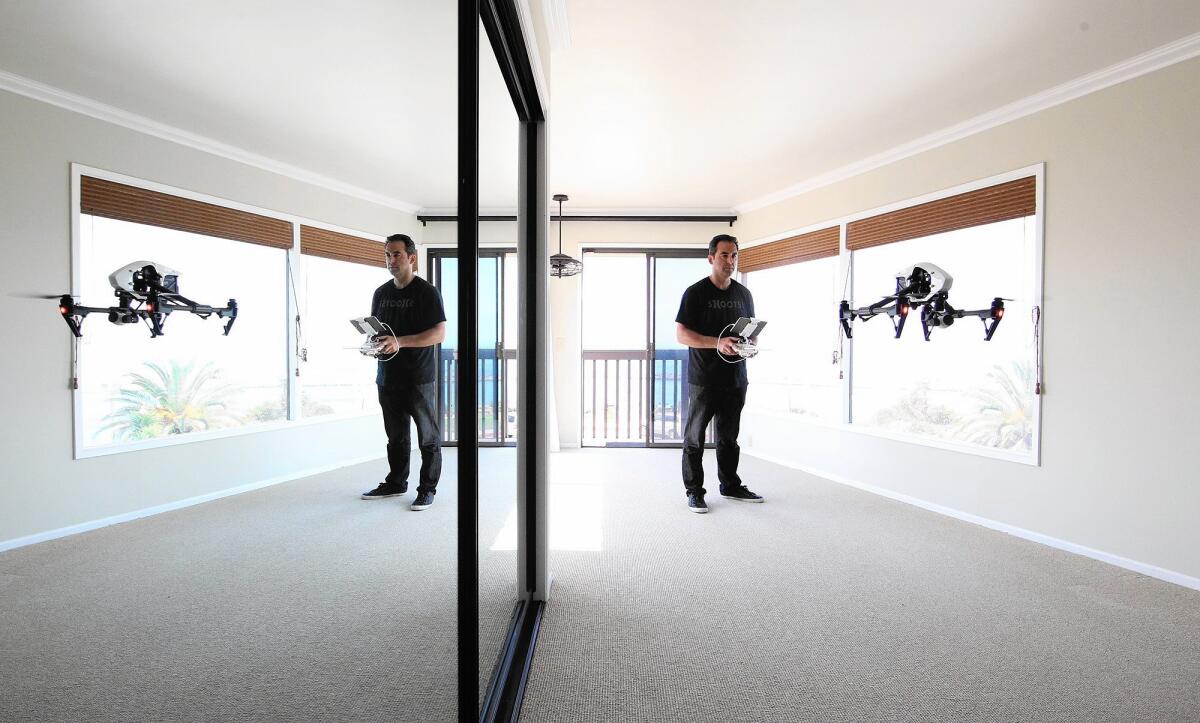New real estate tool: drones

Beautiful location as it is, the home on Ocean Boulevard in Corona del Mar looks even more prestigious from 100 feet up. From there, viewers get a clearer view of the corner lot’s panoramic ocean views, which span Cameo Shores to Catalina Island.
So when Villa Real Estate agents Shana Spitzer and Laura Roche were hired to sell the property, the two turned to Ray Shak to create a sales video that featured aerial images shot by a drone.
Shak, owner of Newport Coast-based Shak Cinema, uses drone and remote-control recording technology for promoting real estate, making documentaries and recording sporting activities, among other services.
Real estate professionals have been exploring the use of drones as a tool to survey property and shoot aerial videos to help market and sell listings for the past couple years.
“You can’t capture this in a still picture,” Spitzer said as she stood in front of the home, which is steps aways from Big Corona and China Cove beaches. “That’s why the video was so critical to use, because we needed to capture the whole vibe of the beaches at Southern California.”
Spitzer and Roche said the aerial perspective of a property also has particular appeal to out-of-state and international buyers, who make up most of their clientele.
The Corona del Mar home, which is set up as a three-bedroom, with two additional rooms used as an office and bonus room, could be lived in as is, but it could also stand to be remodeled or rebuilt. It was listed at $5.99 million and is now in escrow.
“Clients have higher expectations, and with a 360-degree view, they can see the home in less than three minutes,” Shak said. “We live in an era of video, and it’s obvious that it’s popular because it’s much more interactive than still photos.”
Shak, who founded his photography and cinematography company two years ago, said his interest in flying drones started out as a hobby.
He has over 12 drones, which range in price from $4,000 to $15,000. The most popular brand to use, he said, is DJI, a Chinese technology company that manufacturers commercial and recreational unmanned aerial vehicles for aerial photography and videography.
Very few drones offer more than 10 to 20 minutes of battery life, but DJI drones can go faster — around 34 miles per hour — and stay airborne for up to 25 minutes on one charge, he said.
Shak said the cost of using drones in real estate is usually not passed onto the homeowner, since agents typically absorb costs associated with the marketing of a property.
When he first looks at a home’s exterior, Shak said, he tries to get a general idea of how the house is situated and how to showcase its view, if it has one.
To show the home’s interior, he uses ground cameras with hand-held stabilizers for a visual walk-through.
Business has been growing, he said.
“Everyone is used to a still photo, but you have to show a bird’s-eye view,” Shak said. “Video also helps the agents with their next listing because they’re able to show a previous video and say, ‘This is what I have sold in the past.’ The client is more impressed, and the agent has a much more complete portfolio.”
The tiny aircraft has become a popular tool among real estate industry professionals since 2013. That’s when President Obama signed into law the Air Transportation Modernization and Safety Improvement Act, authorizing the Federal Aviation Administration to allow drones to be used for commercial purposes.
Real-estate businesses won nearly a third of the first 500 commercial drone permits granted, according to a study by the trade group Assn. for Unmanned Vehicle Systems International. In California, 70 businesses have drone-use permits.
The FAA has basic standing guidelines and rules. For instance, drones may not be flown withing three miles of an airport and landing strip, the craft must remain within the user’s line of sight and it may not be flown above 400 feet or near pedestrians or wildlife.
Patti English, owner of the Corona del Mar property, said that when Spitzer and Roche suggested they create a drone video, she and her family agreed that it seemed to be the best solution for showing the property.
“We were surprised at the number of people who saw the video and feel that it helped sell our house at top dollar,” English said in an email. “The video really showed the views that property has up and down the coast, plus the proximity to the harbor, which was a huge selling point.”
Drones have helped make the overall buying and selling process more efficient, since prospective buyers have video listings of large estates, Spitzer and Roche said.
“You have to stay on top of technology, in real estate especially, since it’s a competitive industry,” Roche said. “You need every cutting edge, and it turns out we get more of a response from buyers with videos than photos. It’s like telling a story of a home where you want people to envision their lifestyle and you feel like you’re seeing it through the eyes of the drone.”
